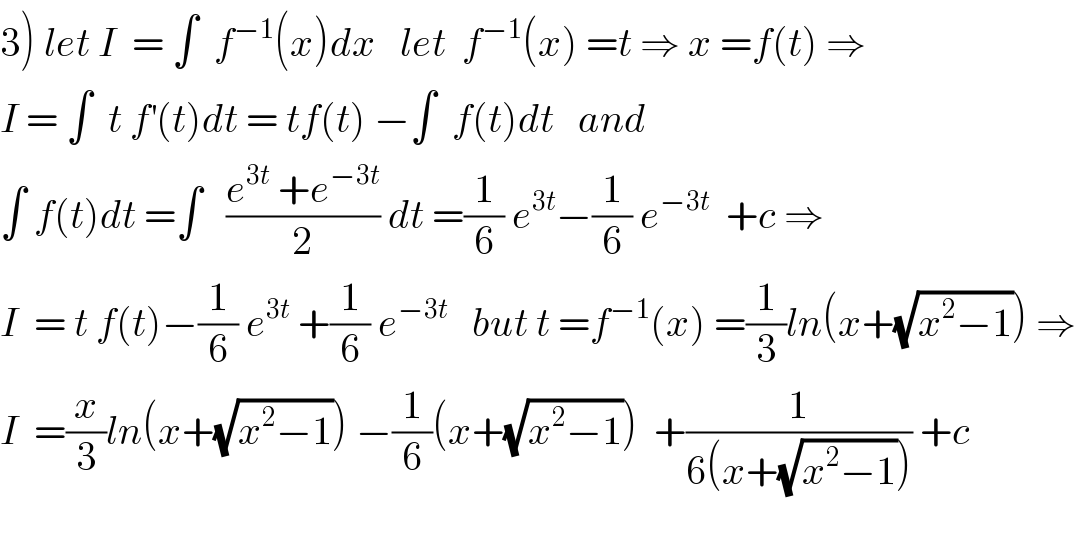
Question and Answers Forum
Question Number 42704 by maxmathsup by imad last updated on 01/Sep/18
![f(x) = ((e^(3x) +e^(−3x) )/2) 1) determine f^(−1) (x) 2) calculate ∫_0 ^1 x f(x)dx and ∫_0 ^1 f(x)dx 3) calculate ∫ f^(−1) (x)dx 4) calculate u_n = ∫_0 ^π f(x)cos(nx)dx and v_n = ∫_0 ^n f(x)sin(nx)dx find nature of Σ (v_n /u_n ) ∫_0 ^1 xf(x) dx =(1/2) ∫_0 ^1 x e^(3x) dx +(1/2) ∫_0 ^1 x e^(−3x) dx (by parts) =(1/2){ [(x/3)e^(3x) ]_0 ^1 −(1/3)∫_0 ^1 e^(3x) dx +[−(x/3)e^(−3x) ]_0 ^1 +(1/3)∫_0 ^1 e^(−3x) dx} =(1/2){(e^3 /3) −(1/9)(e^3 −1) −(e^(−3) /3) −(1/9)(e^(−3) −1)}](Q42704.png)
Commented by maxmathsup by imad last updated on 01/Sep/18
![1) f(x)=ch(3x) =y ⇔ 3x =argch(y) ⇔x =(1/3)argch(y) =(1/3)ln(y+(√(y^2 −1))) ⇒ f^(−1) (x) =(1/3)ln(y+(√(y^2 −1))) 2)∫_0 ^1 f(x)dx = (1/2)∫_0 ^1 ( e^(3x) +e^(−3x) )dx =(1/2)[(1/3)e^(3x) −(1/3)e^(−3x) ]_0 ^1 =(1/6){e^3 −e^(−3) }](Q42732.png)
Commented by maxmathsup by imad last updated on 01/Sep/18

Commented by maxmathsup by imad last updated on 02/Sep/18
![4) we have u_n = ∫_0 ^π f(x)cos(nx)dx =(1/2) ∫_0 ^π (e^(3x) +e^(−3x) )cos(nx)dx ⇒ 2u_n = Re( ∫_0 ^π e^(inx) (e^(3x) +e^(−3x) )dx) =Re( ∫_0 ^π e^((3+in)x) + e^((−3+in)x) )dx but ∫_0 ^π ( e^((3+in)x) +e^((−3+in)x) )dx =[(1/(3+in)) e^((3+in)x) +(1/(−3+in)) e^((−3+in)x) ]_0 ^π =((e^(3π) (−1)^n )/(3+in)) +((e^(−3π) (−1)^n )/(−3 +in)) −(1/(3+in)) −(1/(−3+in)) =(((3−in) e^(3π) (−1)^n )/(9+n^2 )) + (((−3−in)e^(−3π) (−1)^n )/(9+n^2 )) −(1/(3+in)) +(1/(3−in)) =(((−1)^n )/(9+n^2 )) { 3 e^(3π) −in e^(3π) −3 e^(−3π) −in e^(−3π) } +(1/(3−in)) −(1/(3+in)) =((3(−1)^n )/(9+n^2 )){ e^(3π) −e^(−3π) } −((n(−1)^n )/(9+n^2 ))i {e^(3π) +e^(−3π) } +((2in)/(9+n^2 )) ⇒ u_n = ((3(−1)^n (e^(3π) −e^(−3π) ))/(9+n^2 )) also we have v_n = Im(∫_0 ^π e^((3+in)x) +e^((−3+in)x) )dx) ⇒v_n =((2n −n(−1)^n )/(9+n^2 )) .](Q42735.png)
Commented by maxmathsup by imad last updated on 02/Sep/18

